Ancient impacts played a powerful role in Earth’s complex history. On other Solar System bodies like the Moon or Mercury, the impact history is preserved on their surfaces because there’s nothing to erase it. But Earth’s geologic activity has erased the evidence of impact craters over time, with some help from erosion.
Earth’s complex history has elevated its status among its Solar System siblings and created a world that’s rippling with life. Ancient giant impacts have played a role in that history, bringing catastrophe and disruption and irrevocably changing the course of events. Deciphering the role these giant impacts played is difficult since the evidence is missing or severely degraded. So how do scientists approach this problem?
One crater at a time.
The most well-known giant impact on Earth is the Chicxulub impactor which wiped out the dinosaurs about 65 million years ago and cleared the way for mammals to become preeminent. But there’ve been other giant impacts, including one in South Africa. It’s called the Vredefort Crater, and it’s Earth’s largest confirmed impact crater.
“Understanding the largest impact structure that we have on Earth is critical.”
The Vredefort impactor struck Earth about 2 billion years ago during the Paleoproterozoic Era and is now located in South Africa. Previous research put the Vredefort impactor at between 10 to 15 km in diameter, and the crater — or impact structure as scientists call them — was about 160–300 km (100–200 mi) across when it was formed. Erosion has reduced its size in the two billion intervening years, though, making the nature of the impactor, the size of the crater, and the impact’s effects difficult to gauge accurately.
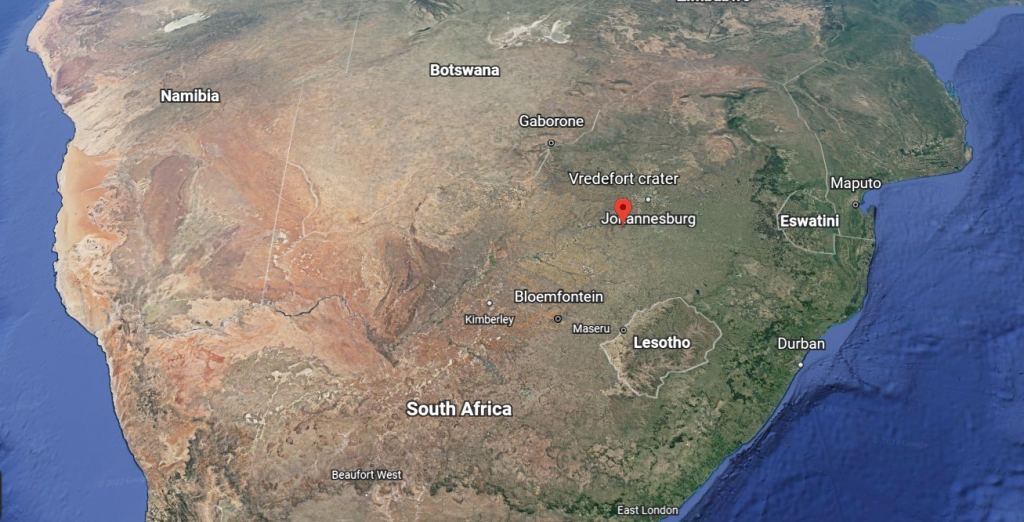 The Vredefort crater is a two-billion-year-old impact structure located in South Africa. Image Credit: Google Earth.
The Vredefort crater is a two-billion-year-old impact structure located in South Africa. Image Credit: Google Earth.But new research published in the Journal of Geophysical Research: Planets arrives at a different size and impact velocity for the Vredefort impactor. The study’s authors say that the impactor was larger than thought, struck Earth at a greater velocity than thought, and had devastating and far-reaching consequences.
The study is “A Revision of the Formation Conditions of the Vredefort Crater.” The lead author is Natalie Allen, a Ph.D. student in the department of Physics and Astronomy at Johns Hopkins University.
“Understanding the largest impact structure that we have on Earth is critical,” Allen said in a press release. “Having access to the information provided by a structure like the Vredefort crater is a great opportunity to test our model and our understanding of the geologic evidence so we can better understand impacts on Earth and beyond.”
More recent impacts like the Chicxulub event also had far-reaching and catastrophic consequences. Chicxulub caused megatsunamis, violent earthquakes, firestorms that turned forests to ash and cinders, atmospheric dust accumulations that caused global temperatures to drop for a sustained period of time, and of course, the extinction of the dinosaurs. But Earth was much different when the Vredefort impact event occurred in the Paleoproterozoic Era. There were no animals and no forests.
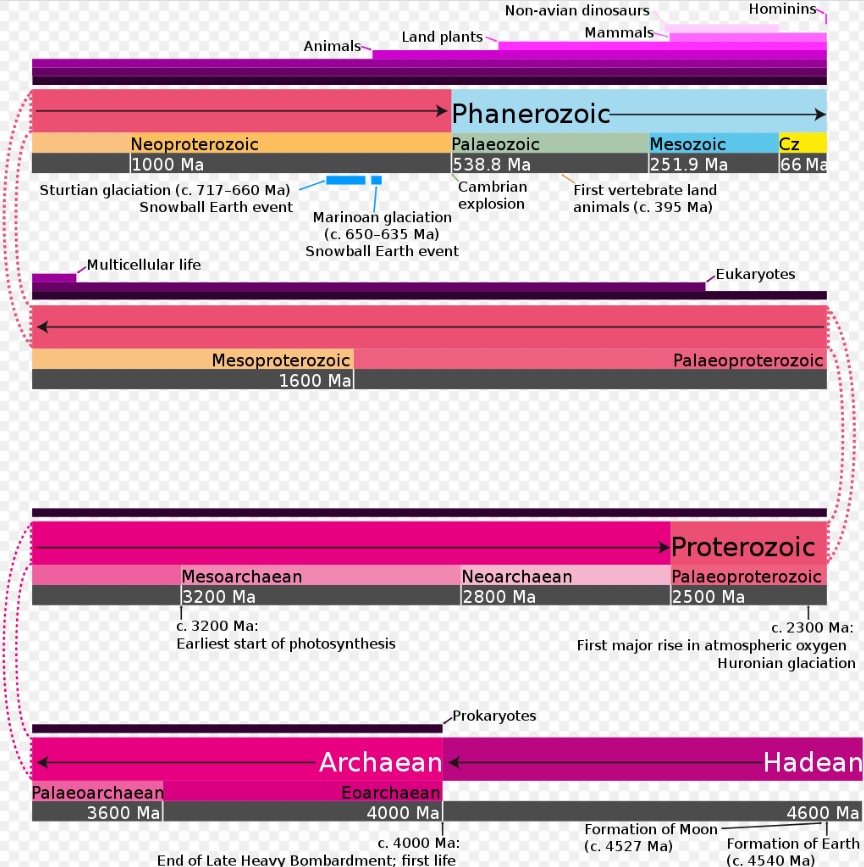 Earth was much different during the Paleoproterozoic Era 2 billion years ago. There was only simple life, oxygen was starting to accumulate in the atmosphere, and eukaryotes were just starting to appear. Image Credit: Geologic time scale. (2022, September 30). In Wikipedia. https://en.wikipedia.org/wiki/Geologic_time_scale.
Earth was much different during the Paleoproterozoic Era 2 billion years ago. There was only simple life, oxygen was starting to accumulate in the atmosphere, and eukaryotes were just starting to appear. Image Credit: Geologic time scale. (2022, September 30). In Wikipedia. https://en.wikipedia.org/wiki/Geologic_time_scale.Previous estimates for the Vredefort impactor place it at about 15 km in diameter with an impact velocity of 15 km/s. That would excavate a crater about 172 km in diameter. The crater has eroded extensively in the intervening two billion years, so earlier geologic evidence supported the “15×15” estimation. But the problem is that the crater is now understood to be much larger. The most relied-upon modern estimation for the crater is between 250 to 280 km (155 to 174 miles.) To help sort out the discrepancy, the authors of this study brought new tools to bear on the Vredefort impact event in the form of computer simulations.
The researchers ran simulations with the “impact code iSALE2D (impact Simplified Arbitrary Lagrangian Eulerian)” tool. It’s a shock physics simulation tool that helps researchers understand impact events. Scientists use it to simulate impacts and reproduce their effects. Their simulations led to an impactor size and velocity that more accurately reflects modern evidence. The researchers say that the Vredefort impactor was actually either a 25 km diameter body travelling at 15 km/s or a 20 km diameter body travelling at 20 km/s.
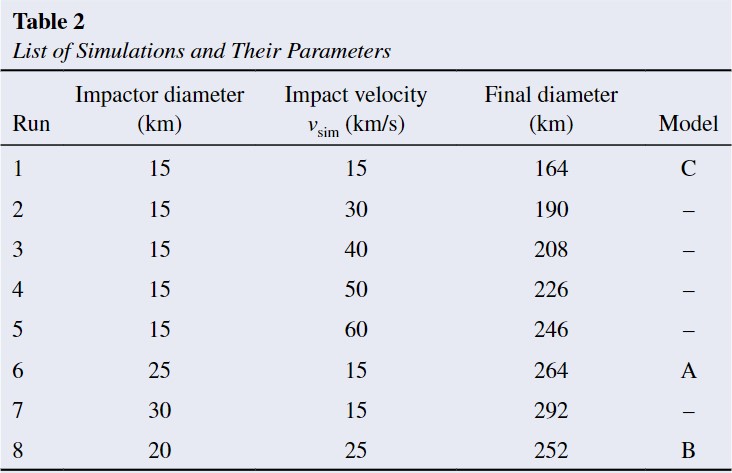 This table shows some of the simulation results in the study. Each combination of impactor diameter and velocity produces a different-sized crater or impact structure. C in the right column reflects previous estimates for the Vredefort impactor, while A and B reflect the study’s results, which the authors think most accurately match the evidence. Image Credit: Allen et. al. 2022.
This table shows some of the simulation results in the study. Each combination of impactor diameter and velocity produces a different-sized crater or impact structure. C in the right column reflects previous estimates for the Vredefort impactor, while A and B reflect the study’s results, which the authors think most accurately match the evidence. Image Credit: Allen et. al. 2022.The size of the crater isn’t the only evidence that lines up with the impactor’s revised diameter and velocity. Certain features in the rock under the impact site also suggest a larger impactor than thought. Researchers have found shock-metamorphic features in the Vredefort impact structure, including “… breccia, shatter cones, planar deformation features in quartz and zircon, and melt,” the authors write. Their location suggests that the impact was more powerful than thought.
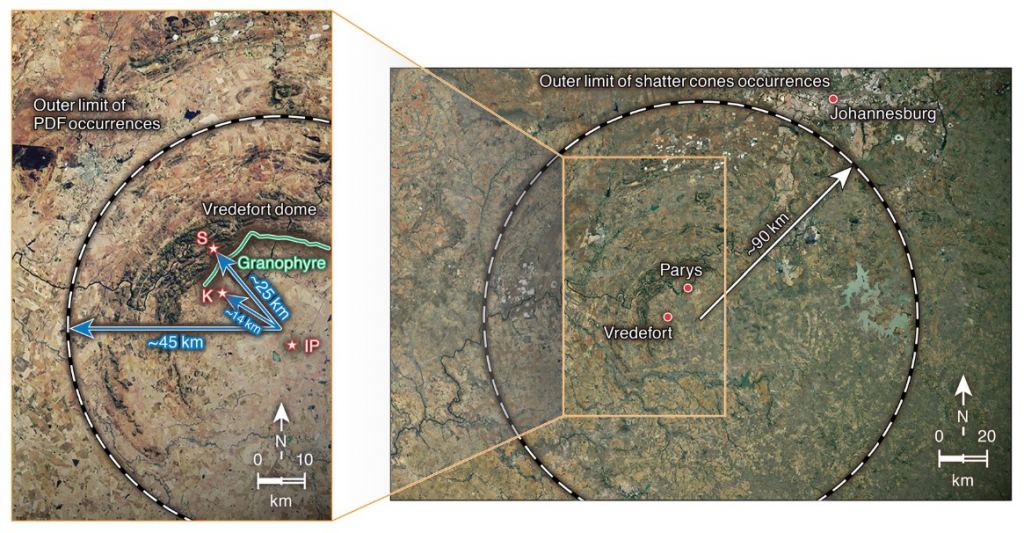 This image from the study shows the Vredefort dome today, with different parts of the impact structure labelled. PDFs are Planar Deformation Features which are present in zircon and quartz and caused by powerful shocks. Shatter cones are rare geological features which only form under impact sites. Granophyre is a geologic feature also formed by impacts. “S,” “K,”, and “IP” are sample collection sites from previous studies. Image Credit: Vredefort Crater, accessed on 20 August 2020 from NASA’s Earth Observatory. Allen et. al. 2022.
This image from the study shows the Vredefort dome today, with different parts of the impact structure labelled. PDFs are Planar Deformation Features which are present in zircon and quartz and caused by powerful shocks. Shatter cones are rare geological features which only form under impact sites. Granophyre is a geologic feature also formed by impacts. “S,” “K,”, and “IP” are sample collection sites from previous studies. Image Credit: Vredefort Crater, accessed on 20 August 2020 from NASA’s Earth Observatory. Allen et. al. 2022.These revised results for the Vredefort impact mean that the impact was more energetic than previously thought. The impact dwarfs that of the dinosaur-killing Chicxulub impactor. Chicxulub was catastrophic for life on Earth at the time, so the Vredefort impact would’ve been a mega-catastrophe. However, it left no record of a mass extinction and no consistent layer of ash around the globe like Chicxulub did. What havoc did the Vredefort impactor wreak on Earth?
“Unlike the Chicxulub impact, the Vredefort impact did not leave a record of mass extinction or forest fires, given that there were only single-cell lifeforms and no trees existed two billion years ago,” said Prof. Miki Nakajima, one of the paper’s authors also from Johns Hopkins. “However, the impact would have affected the global climate potentially more extensively than the Chicxulub impact did.”
The impact thickened the atmosphere with dust and aerosols, blocking out sunlight and causing temperatures to drop. At the time, oxygen was accumulating in the atmosphere, and photosynthetic organisms were widespread and had been around for a billion years already. What happened to them?
“This could have had a devastating effect on photosynthetic organisms,” Nakajima said. “After the dust and aerosols settled—which could have taken anywhere from hours to a decade—greenhouse gases such as carbon dioxide that were emitted from the impact would have raised the global temperature potentially by several degrees for a long period of time.”
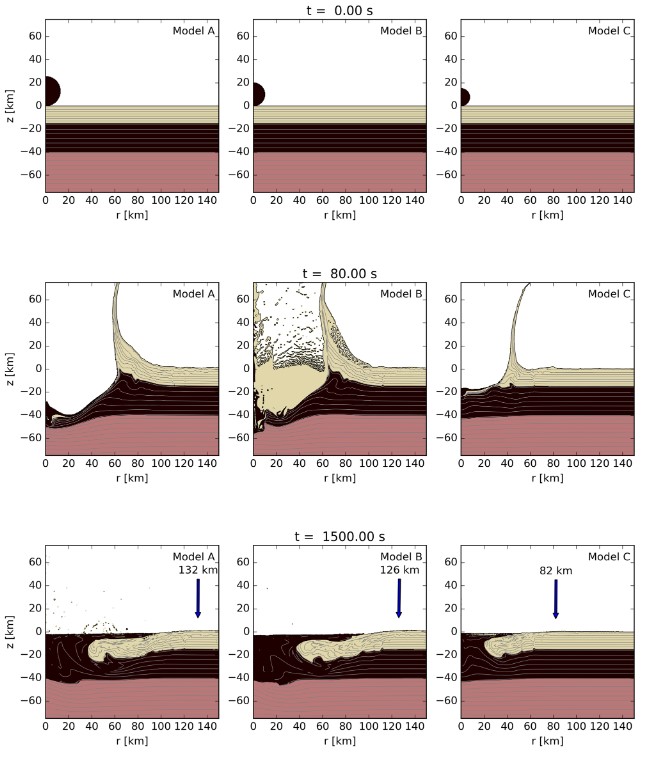 This image from the study shows three simulation runs, A, B, and C, at three distinct times with different impactor sizes. The top row is at t = 0.0 seconds, right at the time of impact. The middle row is at t = 80 seconds, and the bottom row is at t = 1500 seconds, 25 minutes after impact. The blue arrows in the bottom row show the point at which the crater reached equilibrium when the physical forces from the impact subside, and the crater takes its final shape. A and B more closely resemble the Vredefort crater. Image Credit: Allen et. al. 2022.
This image from the study shows three simulation runs, A, B, and C, at three distinct times with different impactor sizes. The top row is at t = 0.0 seconds, right at the time of impact. The middle row is at t = 80 seconds, and the bottom row is at t = 1500 seconds, 25 minutes after impact. The blue arrows in the bottom row show the point at which the crater reached equilibrium when the physical forces from the impact subside, and the crater takes its final shape. A and B more closely resemble the Vredefort crater. Image Credit: Allen et. al. 2022.As we see all around us, a temperature rise of only a couple of degrees has a powerful effect on the global climate. Flooding, hurricanes, droughts and other phenomena are occurring with greater frequency in our warming world. Geologic evidence is hard to come by, but two billion years ago, Earth was just coming out of the Huronian Glaciation, so there was likely a lot of ice on the planet’s surface. If the Vredefort impact raised global temperatures, melting might have raised the ocean level considerably. The impact may also have heralded a period of violent storms, though there’s no way of knowing for sure.
The authors refrain from an exact explanation of the consequences for life on Earth at the time. But they do arrive at several conclusions.
Previous estimates of the crater size and the impactor size don’t match the geologic evidence. The weaker impact from previous research is unable to create enough pressure to create the geologic features at the Vredefort impact site.
Impacts of this size also create a melt sheet under the impact site. While much of it would’ve eroded over the two billion years, the team’s models show some should still exist under the center, where it’s found today.
Another of their conclusions concerns the locations of the land masses two billion years ago. We know the continents have drifted considerably and were even joined together in the past, but pinning down their precise locations at specific times is difficult. Scientists have found ejecta from the Vredefort impact at different locations around the globe, especially in Karelia, Russia, and they know how far ejecta can travel from an impact of a given energy. So with a more accurate understanding of the energy of Vredefort’s impact, the authors were able to constrain the location of Karelia at the time of impact. When the Vredefort impact struck, Karelia was between 2,000 to 2,500 km from the impact site. Now they’re four times as distant from one another.
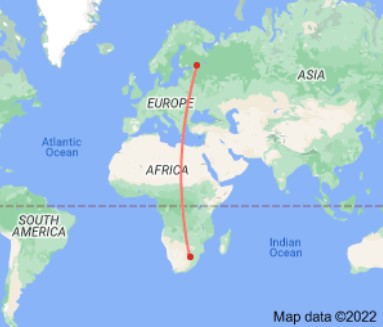 The Karelia region straddles Russia and Finland. The study shows that at the time of the Vredefort impact, Vredefort and Karelia were between 2,000 and 2,500 km apart. Now they’re almost 10,000 km apart. Image Credit: Google Earth.
The Karelia region straddles Russia and Finland. The study shows that at the time of the Vredefort impact, Vredefort and Karelia were between 2,000 and 2,500 km apart. Now they’re almost 10,000 km apart. Image Credit: Google Earth.“It is incredibly difficult to constrain the location of landmasses long ago,” Allen says. “The current best simulations have mapped back about a billion years, and uncertainties grow larger the further back you go. Clarifying evidence such as this ejecta layer mapping may allow researchers to test their models and help complete the view into the past.”
It’ll be difficult for scientists to ever understand what happened to life on Earth when the Vredefort impactor struck. The vast quantities of gases released, along with all the dust, may have rendered photosynthesis ineffective for large parts of the globe. It may have taken ten years for all that dust to settle and for the gases to leave the atmosphere. It was a catastrophe any way you slice it.
Life on Earth has run a gauntlet of catastrophic impacts, extinctions, and global climate gyrations. The dinosaur-killing Chicxulub impactor puts heavy emphasis on that. But this study shows that massive impacts may have shaped the course of life on Earth, even when that life was only single-celled. What specific effects did the Vredefort impact have on life’s long evolutionary journey?
“The global effects of this impact would have been extensive,” the authors write. “The liberation of climatic gases would have altered the global climate, but predictions further than that require study beyond the scope of this work.”

